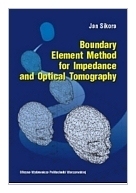|

BOUNDARY ELEMENT METHOD FOR IMPEDANCE AND OPTICAL TOMOGRAPHY
SIKORA J. wydawnictwo: WYD PW , rok wydania 2013, wydanie I cena netto: 24.10 Twoja cena 22,90 zł + 5% vat - dodaj do koszyka Boundary Element Method for Impedance and Optical Tomography
List of symbols
Introduction
1. Two–dimensional potential problems
1.1. Introduction
1.2. Laplace equation
1.2.1. Division of the boundary into constant boundary elements
1.2.2. Numerical integration of the kernels
1.2.3. Division of the boundary into linear boundary elements
1.2.4. Numerical integration of the kernels
1.2.5. Division of the boundary into quadratic boundary elements
1.2.6. Numerical integration of the kernels
1.2.7. Numerical integration of the c(r) coefficient
1.2.8. Internal points calculation
1.2.9. Symbolic calculation
1.3. Diffusion equation
1.3.1. Treatment of singularity
1.3.2. Internal points calculation
1.3.3. Example
1.4. Diffusion equation in frequency domain
1.4.1. Treatment of singularity
1.4.2. Internal points calculation
1.5. Examples
1.5.1. Cartesian coordinate system
1.5.2. Polar coordinate system
1.5.3. Distributed source for a diffusion model for light transport
1.5.4. Point source located on the boundary for a diffusion model for light transport
1.5.5. Point source located inside the region for a diffusion model for light transport
1.5.6. Comparison FEM and BEM results of calculation
1.5.7. Conclusion
1.6. Anisotropic medium
1.6.1. Anisotropy model
1.6.2. Treatment of singularity
1.6.3. Comparison FEM and BEM results
1.7. Galerkin formulation of boundary integral equations
1.7.1. Analytical integrations of coincident integrands
1.7.2. Numerical integrations of coincident integrands
2. Three-dimensional potential problems
2.1. Introduction
2.2. Singular and nearly singular integrals
2.3. Governing equations
2.4. Zero–order interpolation functions
2.4.1. Jacobian
2.4.2. Integration of non–singular integrals over the triangle
2.4.3. Integration of singular integrals
2.5. First–order interpolation functions
2.6. Second–order interpolation functions
2.6.1. Triangular boundary elements
2.6.2. Numerical integration of singular integrals
2.6.3. Quadrilateral boundary elements
2.6.4. Integration of non–singular integrals over the square
2.6.5. Integration of singular integrals over the square
2.7. Treatment of Boundary Conditions
2.7.1. Dirichlet boundary conditions
2.7.2. Neumann boundary conditions
2.7.3. Robin boundary conditions
2.7.4. Mixed boundary conditions
2.8. Non–homogeneity
2.9. Index mismatched diffusive/diffusive interfaces
2.9.1. Approximate interface conditions
2.9.2. Complete interface conditions
2.10. Numerical examples
2.10.1. Cube
2.10.2. Two concentric spheres
2.10.3. The proximity effect
2.10.4. Results for spatially non–homogeneous region in 2D space
3. Diffusion model for light transport in the frequency domain
3.1. Governing equations
3.1.1. Two dimensional space
3.1.2. Three dimensional space
3.1.3. The Boundary Element Method
3.2. Numerical Implementation
3.2.1. Jacobian
3.2.2. Matrix Assembly
3.3. Numerical integration of singular integrals in 3D
3.3.1. Mapping formula for triangular constant element
3.3.2. Isoparametric triangular quadratic element
3.3.3. Isoparametric quadrilateral quadratic element
3.4. Results for 3D
3.4.1. Validation of numerical results
3.4.2. Measures of the accuracy
3.4.3. Quadratic meshing
3.5. Multilayered model of the neonatal head
4. Light propagation in diffusive media with non–scattering regions
4.1. Introduction
4.2. Governing equations for non–scattering sphere embedded in a diffusive spherical
4.2.1. The Boundary Element Method
4.2.2. Matrix form of integral equations
4.3. The Form Factor
4.3.1. The Form Factor calculated analytically
4.3.2. The Form Factor calculated numerically
4.4. Results
4.4.1. The steady state
4.4.2. The frequency domain solution – 100 MHz
4.5. Non–scattering gap between two diffusive regions of a spherical shape
4.5.1. Form Factor calculated analytically
4.5.2. Visibility function calculated analytically
4.5.3. Visibility function calculated numerically
4.5.4. Point in triangle test
4.5.5. Integral equations
4.5.6. Matrix form of integral equations
4.6. Results for the void gap
4.6.1. The steady state
4.6.2. The frequency domain solution – 100 MHz
4.7. Consistency checks for BEM solutions
4.7.1. Diffusion equation case
4.7.2. Radiosity–Diffusion equation case
4.8. Nuutti’s 2D test example
4.8.1. Analytical solution for diffusive boundary conditions
4.8.2. Analytical solution for P1 boundary conditions
4.8.3. Numerical results
4.8.4. Multilayered neonatal head model with the CSF layer
4.9. Conclusion
5. BEM formulation for thin layers
5.1. Introduction
5.2. Standard BEM formulation
5.3. Modification for closely spaced surfaces
5.4. Integration of singular integrals
5.5. Future work
5.6. Conclusion
6. Wavelet based techniques for CPU time reduction
6.1. Discrete wavelet transform
6.2. Time acceleration
6.3. DWT with permutations
6.4. DWT when the size of the coefficient matrix is not a number equal to 2n
6.5. Conclusion
7. FEM–BEM coupling
7.1. 2D space
7.1.1. Incorporating the BE equations to the FE ones
7.2. Numerical examples
7.2.1. Simple benchmark problem
7.2.2. Two squares one immersed in the other
7.2.3. Concentric circles
7.3. 2D void comparison
7.3.1. Boundary conditions at diffusive/non–diffusive interfaces
7.3.2. P1 boundary conditions
7.3.3. Diffusive boundary conditions
8. Miscellaneous
8.1. Introduction to FEM mixed formulation
8.2. Mixed formulation for Laplace equation
8.2.1. Discretization of mixed forms
8.2.2. Robin boundary conditions
8.3. Mixed formulation for Diffusion equation
8.3.1. Three nodes triangle with three degrees of freedom–P1 triangle
8.3.2. Three nodes triangle with the middle sides nodes
8.3.3. Three nodes triangle with a bubble function at the barycenter – P1+ triangle
Bibliography
256 pages, Paperback
Księgarnia nie działa. Nie odpowiadamy na pytania i nie realizujemy zamówien. Do odwolania !.
|


